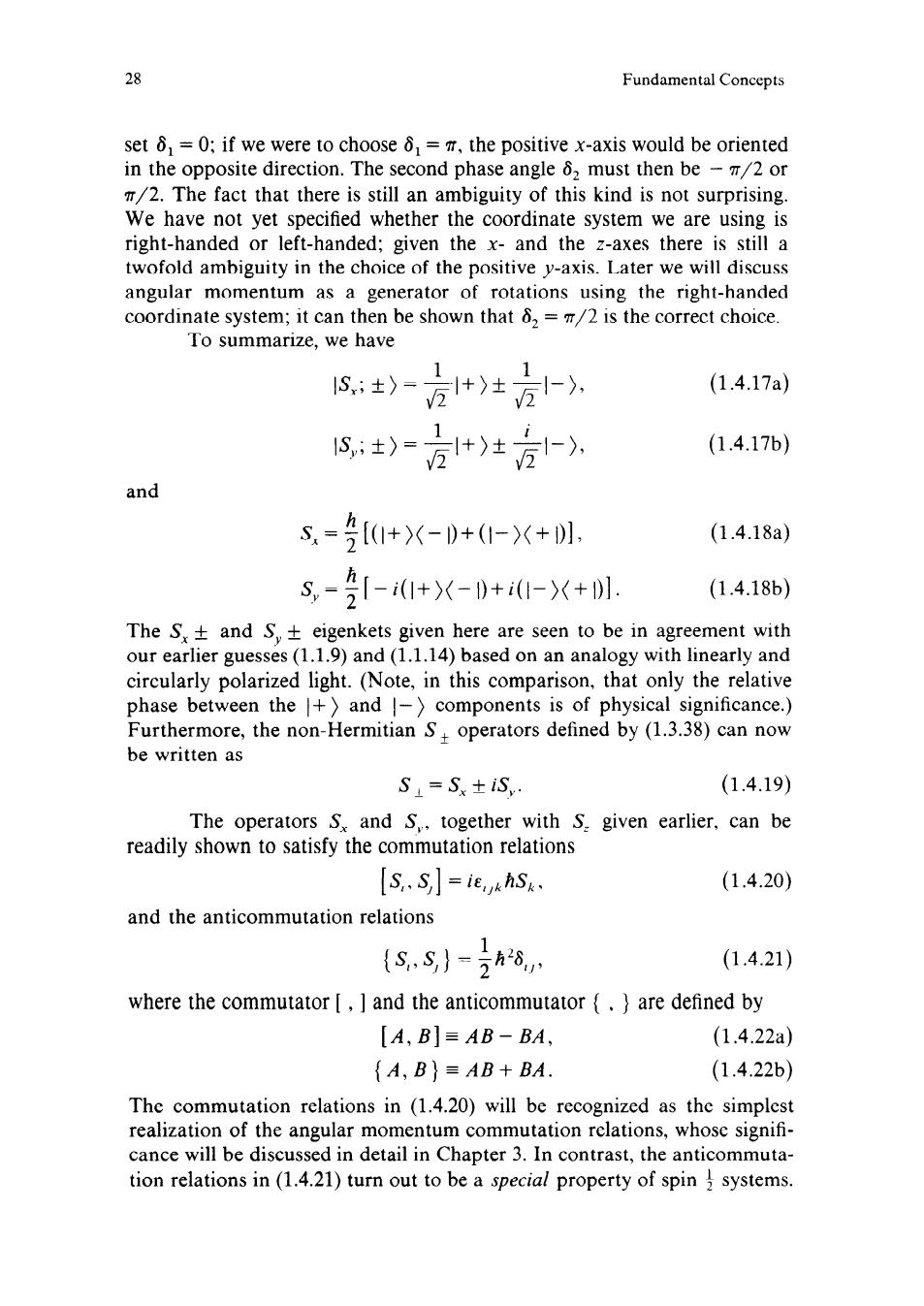
28 Fundamental Concepts set 6,=0:if we were to choose 6=m,the positive x-axis would be oriented in the opposite direction.The second phase angle 8,must then be-7/2 or /2.The fact that there is still an ambiguity of this kind is not surprising We have not yet specified whether the coordinate system we are using is right-handed or left-handed;given the x-and the z-axes there is still a twofold ambiguity in the choice of the positive y-axis.Later we will discuss angular momentum as a generator of rotations using the right-handed coordina ate system;it can en be shown that=2 is the correct choice To summarize,we have IS;±〉= +>± (1.4.17a) lS;±〉= 1+)± (1.4.17b) and S,=号[0+)X-0+(X+l. (1.4.18a) S,--1+X-0+0-X+l. (1.4.18b) The S,+and S+eigenkets given here are seen to be in agreement with our earlier guesses(1.1.9)and (1.1.14)based on an analogy with linearly and circularly polarized light.(Note,in this comparison,that only the relative phase between the|+〉and|-components is s of physic ignificance.) Furthermore,the non-Hermitian S:operators defined by (1.3.38)can now be written as S,=Sx±iS, (1.4.19) The operators S.and S..together with S.given earlier,can be readily shown to satisfy the commutation relations S..S,=ie,hS (1.4.20) and the anticommutation relations {S,S,}=h28 (1.4.21) where the commutator[,and the anticommutator {.are defined by [A,B]=AB-BA, (1.4.22a) (A,B)=AB+BA (1.4.22b) The commutation relations in (1.4.20)will be recognized as the simplest realization of the angular momentum commutation relations,whose signifi- cance will be discussed in detail in Chapter 3.In contrast,the anticommuta- tion relations in(1.4.21)turn out to be a special property of spinsystems
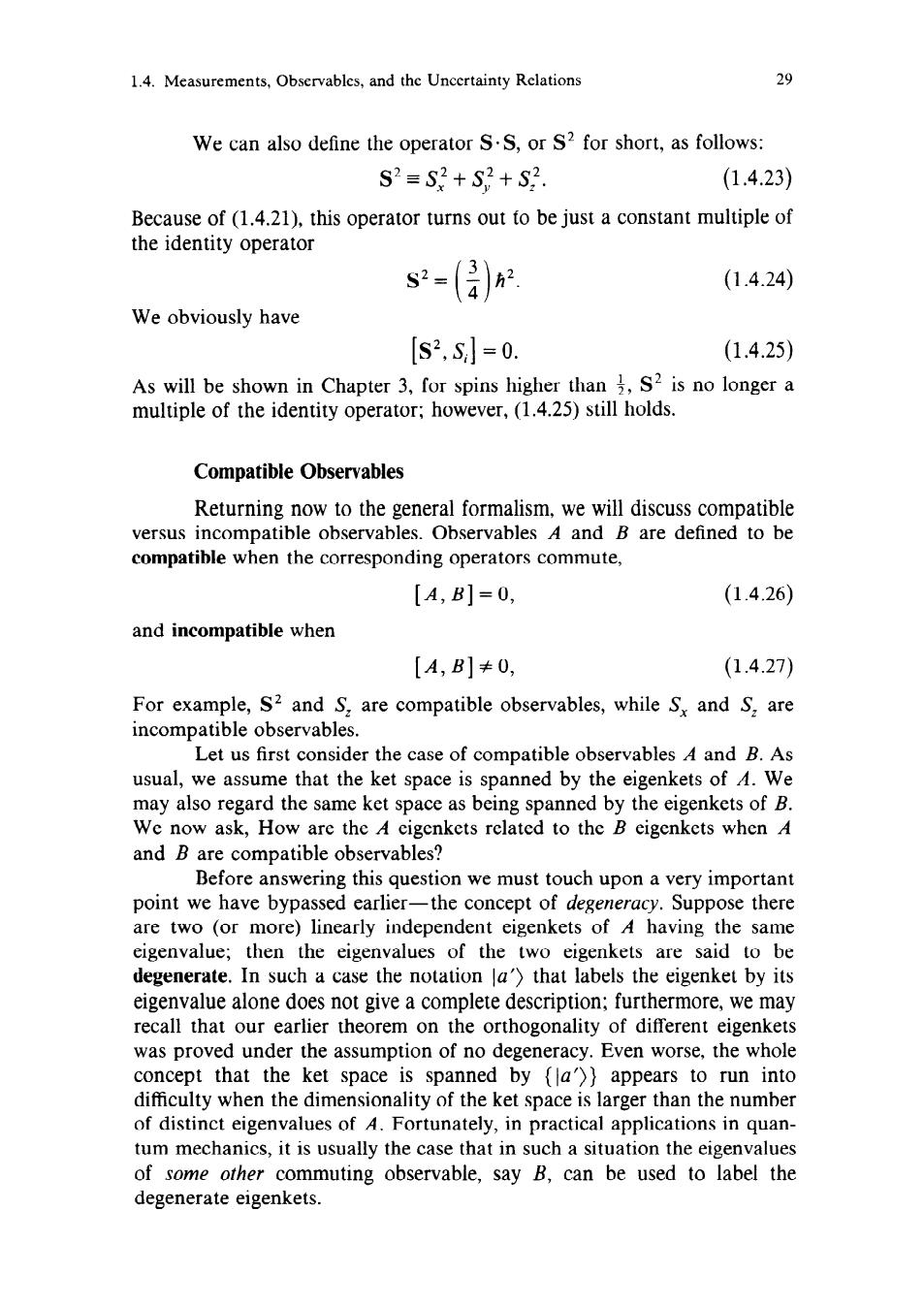
1.4.Measurements,Observables,and the Uncertainty Relations We can also define the operator S.S,or S?for short,as follows: S2=S2+S2+S.2 (1.4.23) Because of(1.4.21).this operator turns out to be just a constant multiple of the identity operator s-(含} (1.4.24) We obviously have [S2,S=0. (1.4.25) As will be shown in Chapter 3.for spins higher than S2 is no longer a multiple of the identity operator;however,(1.4.25)still holds. Compatible Observables Returning now to the general formalism,we will discuss compatible versus incompatible observables.Observables 4 and B are defined to be compatible when the corresponding operators commute. [A,B]=0, (1.4.26) and incompatible when [A,B]+0, (1.4.27) For example,S2 and S.are compatible observables,while S,and S.are incompatible observables. Let us first consider the case of compatible observables 4 and B.As usual,we assume that the ket space is s may also regar rd the same ket space as b enkets of We by the eigenkets of B. We now ask,How are the A cigenkets related to the B eigenkets when A and B are compatible observables? Before answering this question we must touch upon a very mportant point we have bypas cd carli the concept of degenerac Sup se there are two (or more)linearly independent eigenkets of A having the same eigenvalue;then the eigenvalues of the two eigenkets are said to be degenerate.In such a case the notation la')that labels the eigenket by its nay recall that our earlier theorem on the orthogonality of different eigenkets was proved under the assumption of no degeneracy.Even worse,the whole concept that the ket space is spanned by {a)appears to run into difficulty when the dimensionality of the ket ace is large er than the number of distinct alues of A Fortunately,in practical applicat ions in quan- tum mechanics,it is usually the case that in such a situation the eigenvalues of some other commuting observable,say B,can be used to label the degenerate eigenkets
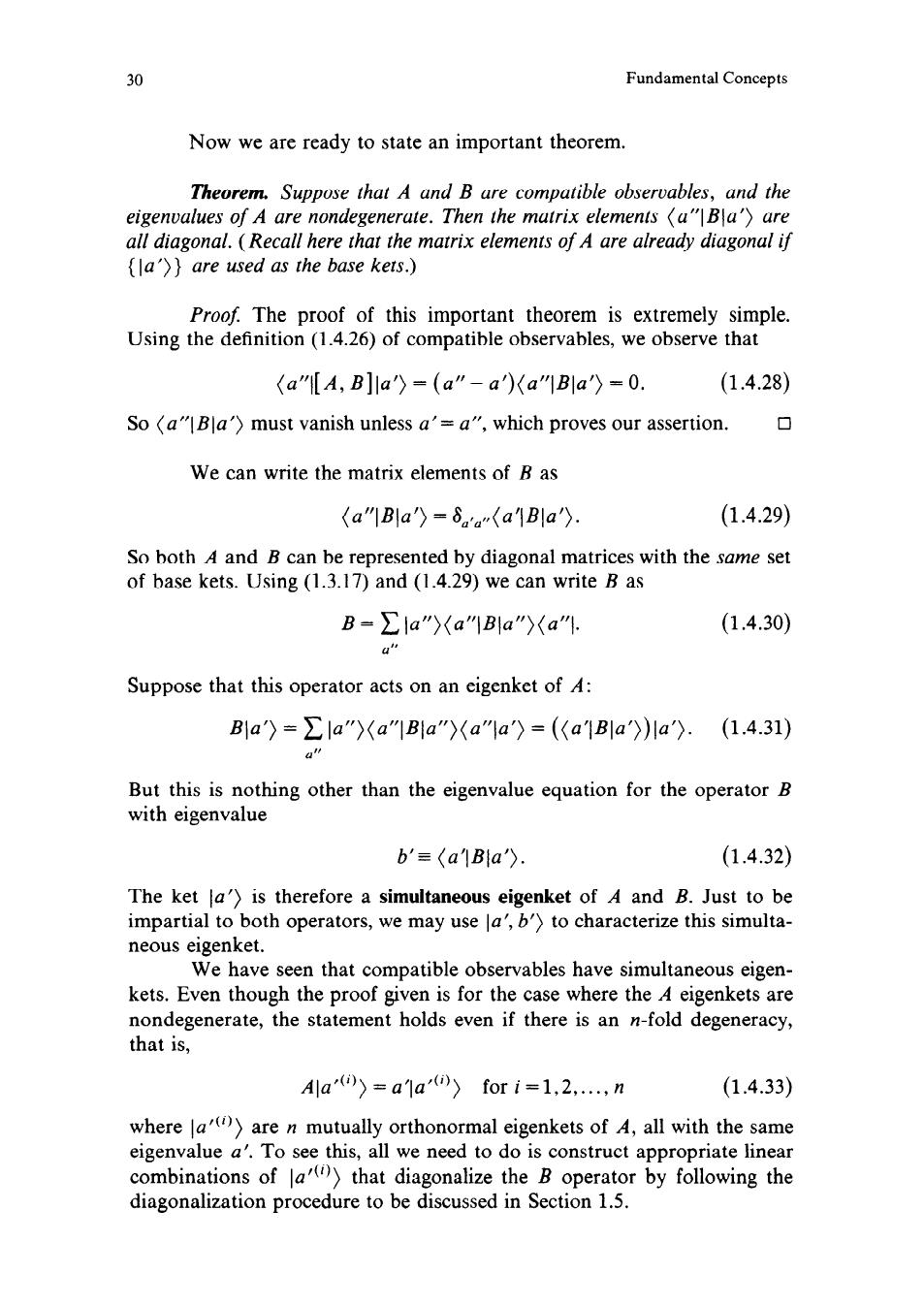
30 Fundamental Concepts Now we are ready to state an important theorem. Theorem.Suppose that A and B are computible observables,and the eigenvalues o are nondegenerate.Then the mutrix elements(" all diagonal.(Recall here that the matrix elements of A are already diagonal if (la'))are used as the base kets.) Proof The r roofof this important theorem is extremely simple P Using the definition(1.4.26)of compatible observables,we observe that a"[A,B]la〉=(a"-a)Ka"Ba〉=0. (1.4.28) So (a"Bla')must vanish unless a'=a",which proves our assertion. ▣ We can write the matrix elements of B as (a"Bla〉=8a(a1Bla (1.4.29) So both 4 and B can be represented by diagonal matrices with the same set of base kets.Using(1.3.17)and (1.4.29)we can write B as B=∑la")Xa"1Bla")(a" (1.4.30) Suppose that this operator acts on an eigenket of A: Bla)=Ela")(a"Bla")(a"la)=((aBla))la).(1.4.31) But this is nothing other than the eigenvalue equation for the operator B with eigenvalue b'=(a1Bfa〉 (1.4.32) The ket a')is therefore a simultaneous eigenket of A and B.Just to be impartial to both operators,we may use la',b')to characterize this simulta- neous eigenket. We have seen that compatible observables have simultaneous eigen kets.Even though the proof given is for the case where the 4 eigenkets are nondegenerate,the statement holds even if there is an n-fold degeneracy, that is. Ala"()=aa"()for i=1,2,...,n (1.4.33) where ()are n mutually orthonormal eigenkets of 4,all with the same eigenvalue a'.To see this,all we need to do is construct appropriate linear combinations of a()that diagonalize the B operator by following the diagonalization procedure to be discussed in Section 1.5
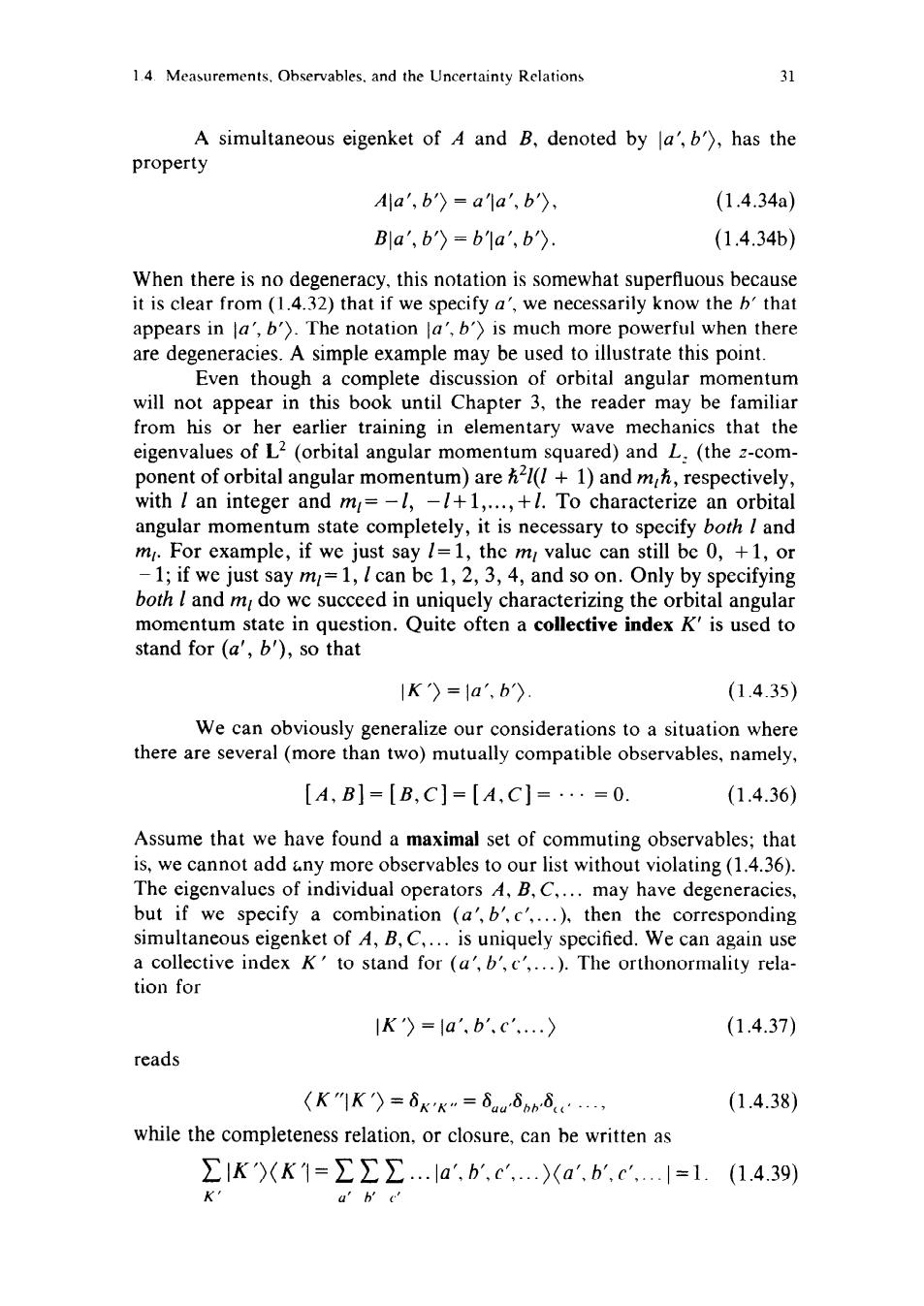
1.4.Measurements.Observables.and the Uncertainty Relations 31 A simultaneous eigenket of 4 and B,denoted by la,b),has the property Aa',b〉=a1a',b〉、 (1.4.34a) Ba',b〉=b1a',b (1.4.34b) When there is no degeneracy.this notation is somewhat superfluous because it is clear m()that f we specify awe necessarily know the tha appears in la',b).The notation la',b')is much more powerful when there are degeneracies.A simple example may be used to illustrate this point. Even though a complete discussion of orbital angular momentum will not appear in this book until Chapter 3,the reader may be familiar from his or earlie training in elementary wave mec anics that the eigenvalues of L (orbital angular momentum squared)and L.(the z-com- ponent of orbital angular momentum)are2(+1)and m,h,respectively, with I an integer and m=-1,-1+1,. ,+l.To characterize an orbital angular momen state completely,it is necess ary to sp ify both I and m.For example,if we just say 1=1,the m valuc can still be 0,+1,or -1;if we just say m=1,l can be 1,2,3,4,and so on.Only by specifying both l and m do we succeed in uniquely characterizing the orbital angular estion.Quite often a collective index K'is used to 1K)=a',b) (1.4.35) We can obviously generalize our considerations to a situation where there are several(more than two)mutually compatible observables,namely, [A,B]=[B,C]=[A,C]=·=0. (1.4.36) Assume that we have found a maximal set of commuting observables;that is,we cannot add any more observables to our list without violating (1.4.36). The eigenvalues of individual operators A,B.C.. may have degeneracies but if we spccify a combination (b then the corresponding simultancous eigenket of A,B.C....is uniquely specified.We can again use a collective index K'to stand for (a',b',c',...).The orthonormality rela- tion for K)=a.b'.c. (1.4.37) reads (K"TK〉=6xKn=6uu6n6c (1.4.38) while the completeness relation.or closure.can be written as ∑lK(K1=∑∑∑a,b',c)(a.b,c|=1.(1.439) a'b'c
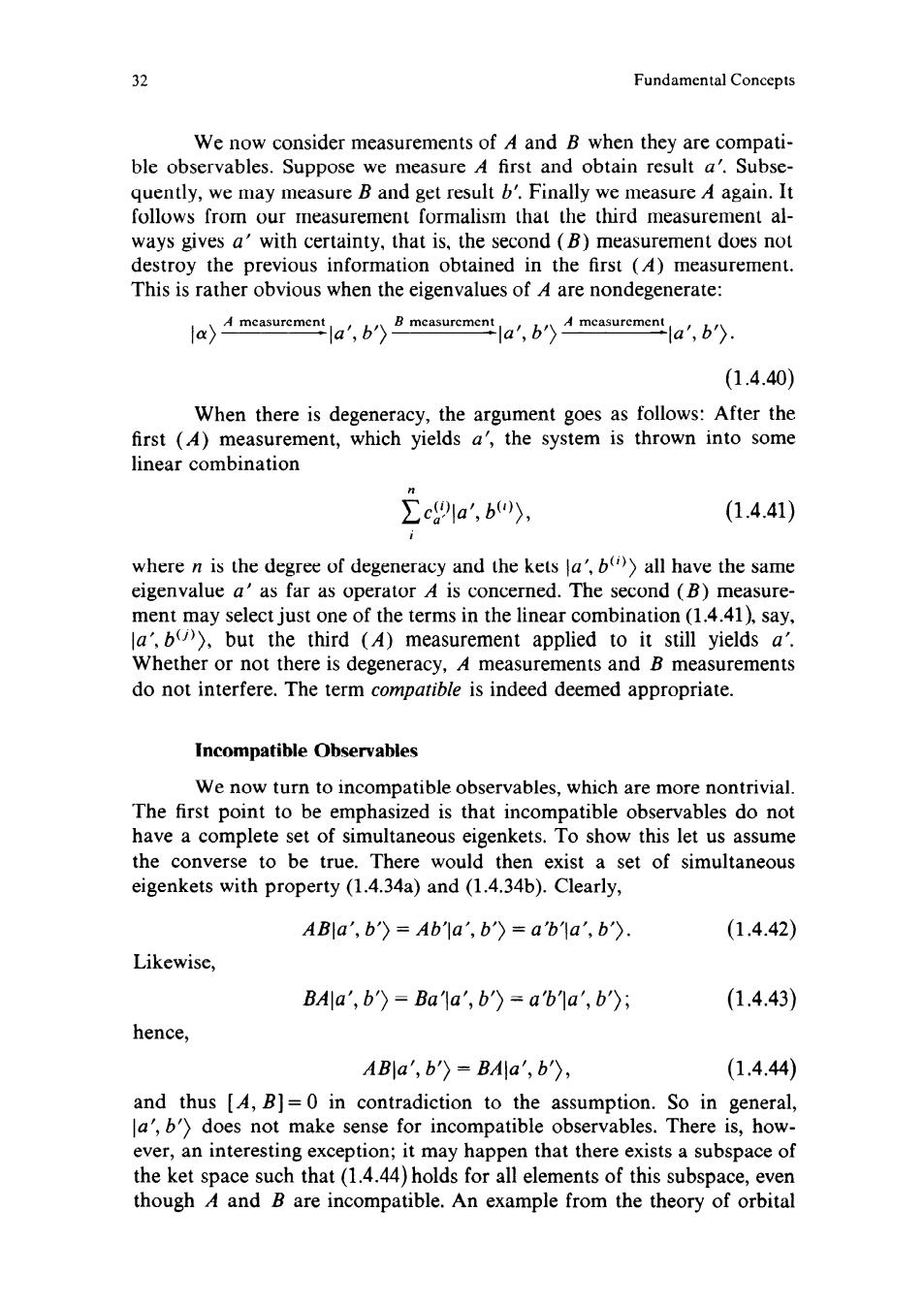
32 Fundamental Concepts We now consider measurements of A and B when they are compati- ble observables.Suppose we measure 4 first and obtain result a'.Subse- quently,we may measure B and get result b'.Finally we measure A again.It follows from ou measuremen form nalism that the third measure ement al. ways gives a'with certainty,that is,the second(B)measurement does not destroy the previous information obtained in the first (A)measurement. This is rather obvious when the eigenvalues of 4 are nondegenerate: la)measurement measurement measuremen (1.4.40) When there is de argument goes as follows:After the first (A)me a,the system is thrown into some linear combination ∑c9a,bo, (1.4.41) where n is the degree of degeneracy and the kets la',b()all have the same nvalue d'as far as operator A is concerned.The second (B)measu ment may select just one of the ombination (1.4.41).say but the third measurement applied to it still yields a Whether or not there is degeneracy,A measurements and B measurements do not interfere.The term compatible is indeed deemed appropriate. Incompatible Observables We now turn to incompatible observables,which are more nontrivial. The first point to be emphasized is that incompatible observables do not have a complete set of simultaneous eigenkets.To show this let us assume the converse to be true.There would then exist a set of simultaneous eigenkets with property (1.4.34a)and(1.4.34b).Clearly, ABla',b')=Ab'la',b')=a'b'la',b'). (1.4.42) Likewise, BAla',b=Bala',b')=a'ba',b'); (1.4.43) hence, ABla',b〉=BAa,b), (1.4.44) ever,an interesting exception;it may happen that there exists a subspace of the ket space such that (1.4.44)holds for all elements of this subspace,even though A and B are incompatible.An example from the theory of orbital